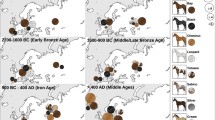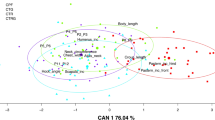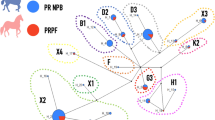Conclusions
-
1.
Striping is distributed among very diverse breeds of domestic horses. It is found more frequently and more dictinctly expressed among primitive, local populations of horses than among standard breeds, due to continued selection against wild coat colors (wilddun, mouse-gray), with which striping is correlated in some way, as yet insufficiently elucidated.
-
2.
Striping in domestic horses in most cases resembles in structure striping in all other species of the familyEquidae (zebras, asses, hemiasses, wild horses) and is by its very nature rudimentary and atavistic (Darwin). The most persistent elements of striping in domestic horses are: the spinal stripe, next horizontal zebroid stripes on the legs, then rudiments of stripes on the vertical system (shoulder stripes and spots); rarely there has been observed the development of arch-shaped stripes on the forehead (Darwin, Ewart, Krieg).
-
3.
A study of variation in such atavistic striping in different breeds of horses throughout the world has made it possible to distinguish two chief types of striping, differing from each other in the structure and localization of the stripes of the vertical system and also in several specific features in the structure of the spinal stripe and the zebroid striping on the legs. The first type of striping (Figs. 1–5) is most clearly expressed in small local breeds of European horses (Ewart's forest type or thenorthern group of Russian authors), but it is also encountered among horses of thesouthern group (eastern type ofFranck) and heavy western horses. The second type (Figs. 6–16) is characteristic of horses of the Mongolian group and is not found beyond the limits of the latter's influence.
-
4.
In addition to atavistic striping in domestic horses, there occurs in very rare cases, striping of a brindling pattern (Figs. 17a, b), which does not possess the characteristic structural features of striping inEquidae and which — like brindling in cattle (Fig. 18) and dogs — must be regarded as a „new formation” of mutational origin.
Similar content being viewed by others
Bibliography
Amschler, W., 1931. Farbengenetische Studien am Altaipferde. Züchtungskunde,6: 250–256.
Antonius, O., 1922. Grundzüge einer Stammesgeschichte der Haustiere. Jena.
Antonius, O., 1932. Die Pferde als aussterbende Tiergruppe. Biologia Generalis,8: 33–44.
Antonius, O., 1933. Über einige Quellen zur Frage der europäischen Wildpferde in historischer Zeit. Ztschr. f. Züchtung, Reihe B, Bd. 27.
Bemmelen, J. F. van, 1931. Farbenzeichnung der Säugetiere. Verh. Deutsch Zool. Ges., 54 Jahresversamml., Zool. Anzeiger, Supplementband 5.
Brauner, A. A., 1922. Animal Husbandry. (In Russian). Odessa.
Darwin, Ch., 1868 (1st ed.): 1875, 1885 (2nd ed.). The variation of animals and plants under domestication. London.
Dobzhansky, Th. G., 1927. Horses of the nomad population of Semirechya Province. (In Russian). Acad. Sci., U.S.S.R. Material of the Special Committee for the Investigation of the Constituent and Autonomous Republics, No. 8, Kazakhstan Series.
Dobzhansky, Th. G. andB. P. Voityatsky, 1920. Horses of the nomad population of Semipalatinsk Province. (In Russian).Loc. cit., Acad. Sci, U.S.S.R. Material of the Special Committee for the Investigation of the Constitutent and Autonomous Republic, No. 18.
Ewart, J. C., 1899. The Penycuik experiments. London.
Ewart, J. C., 1900. Guide to the Zebra Hybrids. Edinburgh.
Ewart, J. C. 1904. The multiple origin of horses and ponies. Trans. Highland Agr. Soc. of Scotland, Vol. 16.
Ewart, J. C., 1909–10. The restoration of an ancient British race of horses. Proc. Roy. Soc. Edinburgh, Vol. 30.
Haecker, V., 1918. Entwicklungsgeschichtliche Eigenschaftsanalyse (Phäno-genetik). Jena.
Hilzheimer, M., 1910. Atavismus. Ztschr. ind. Abst.u. Vererbungsl.,3:201–214.
Hilzheimer, M., 1920. Natürliche Rassengeschichte der Haussäugetiere. Berlin.
Hrasnica Fahrudin, 1938. Beiträge zur Kenntnis der Streifenzeichnung beim bosnischen Gebirgspferde. Z. Tierz. u. Zb. 41. (in Russian).
Keppen, F. P., 1895. A contribution to the history of the Tarpan in Russian. St. Petersburg.
Kholevinsky, A., 1923. A survey of horse breeding in Mongolia. (In Russian). Moscow.
Kohn, F. J., 1909. Über eine Besonderheit der Pferdezeichnung. Zool. Jahrb. Abt. Syst. u. Oekol., Bd. 27.
Krieg, R., 1922. Streifung und Strömung. Arch. f. Entwicklungsmechanik, Bd. 51.
Krieg, H., 1922. Die Prinzipien der Streifenzeichnung bei den Säugetieren. Abgeleitet aus Untersuchungen an den Einhufern. Vorträge und Aufsätze über Entwicklungsmechanik, herausgegeben von Wilh. Roux H. 30, Berlin, 101, 5.
Kuleshov, P. N., 1931. Horse Breeding. (In Russian). Moscow.
Lapshakov, J. G., 1930. The Trans-Baikal horse, Its breeding and care. (In Russian). Khabarovsk.
Lyubimov, N., 1927. The Viatkan Horse. (In Russian). Viatka.
Maligonov, A. A., 1927. On the chief types of Siberian horses. (In Russian). The New Village. Moscow.
Pridorogin, M. I., 1902. Horses of Viatka Province. (In Russian). Bull. Moscow Agr. Inst., Vol. 7, No. 1.
Pridorogin, M. I., 1928. Breeds of Horses. (In Russian).
Ridgeway, W., 1905. The origin and influence of the thoroughbred horse.
Rumyantsev, B. F., 1936. On the origin of the domestic horse. (In Russian; Eng. summary). Bull. Acad. Sci., U.S.S.R., Ser. Biol., No. 2–3.
Rumyantsev, B. F. andB. P. Voityatsky, 1936. The horses of Mongolia. (In Russian). Bull. Mongolian Commission, Acad. Sci. U.S.S.R., No. 22.
Shubskaya, E. I., andF. I. Saltykov, 1931. Yakut cattle. (In Russian). Bull. Council for the Study of Natural Resources, Acad. Sci. U.S.S.R., Yakut Ser., No. 2.
Urusov, S. P., 1899. Russian native breeds of horses (Klepper. Žmudka). (In Russian). Moscow.
Vetulani, T., 1938. Beitrag zur Charakteristik der primitiven Landpferde Polens. Ztschr. Tierz. u. Z.-biologie41:271–304.
Vitt, V. O. 1928. New data on the problem of the inheritance of coat colors in horses. (In Russian). Proc. III All-Union Cong. Zoologists, Anatomists, and Histologists. Leningrad.
Vitt, V. O. (ed.), 1937. Breeds of horses of Central Asia. (In Russian). Lenin Acad. Agr. Sci. Moscow.
Voityatsky, B. P., 1936. Horsebreeding in Daghestan. (Manuscript; in Russian).
Voityatsky, B. P., 1936. Horse Breeding in Karachai. (Manuscript; in Russian).
Wagner, W., 1926. Die Chinesische Landwirtschaft. Berlin.
Warangel, C., 1908–1909. Die Rassen des Pferdes. Stuttgart.
Wriedt, Chr., 1933. Biologische Essays über Pferdezucht und Pferderassen. Russian translation (from the 1929 German edition) by V. O. Lipping, under the editorship of and with a foreword by Prof. V. O. Vitt. State Agr. Pub. House, Leningrad-Moscow, 1933.
Zuitin, A. I. andB. P. Voityatsky, 1930. Horses of the nomad population of Kirghizia. Acad. Sci., U.S.S.R. Material of the Commission on Expeditionary Investigations. No. 22.
Author information
Authors and Affiliations
Rights and permissions
About this article
Cite this article
Lusis, J.A. Striping patterns in domestic horses. Genetica 23, 31–62 (1943). https://doi.org/10.1007/BF01763802
Received:
Issue Date:
DOI: https://doi.org/10.1007/BF01763802




